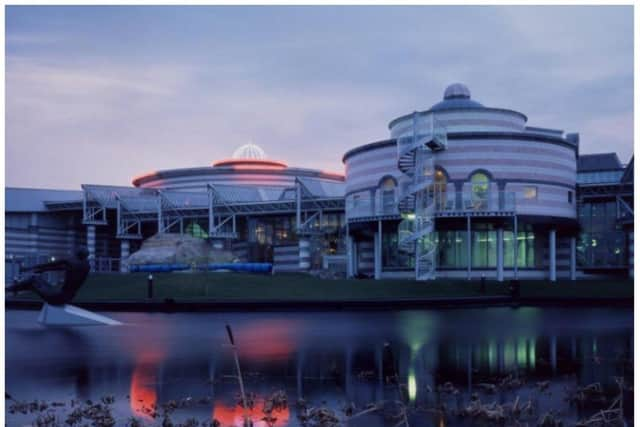The Dome: Doncaster's iconic leisure centre given Grade II listed building status
and live on Freeview channel 276
The building, which was constructed in the late 1980s, is one of 227 places across the UK added to the National Heritage List for England in 2023.
It means the distinctive building will join a list of Grade II listed buildings in Doncaster which already includes Christ Church, The Corn Exchange, Bawtry Hall and Tickhill Castle.
Advertisement
Hide AdAdvertisement
Hide AdCampaigners have been fighting to get The Dome protected status for its pioneering design and architecture for a number of years.


Duncan Wilson, Chief Executive of Historic England which gave The Dome its protected status said: “A range of remarkable historic buildings and sites are added to the List each year and 2023 is no exception.
"We’ve examined and protected some amazing sites this year, which together give us a window into our rich and varied historic environment. The festive period is a great time to find out more about the historic places all around us. I encourage everyone to explore the heritage on our doorsteps.”
In its listing, The Dome is described as an “architecturally striking and inventive late-1980s leisure centre.”
Advertisement
Hide AdAdvertisement
Hide AdAt the time of construction between 1986-1989, The Dome was the largest leisure centre in Europe.
Designed around a huge central atrium, it welcomed visitors to multiple sports with a leisure pool, ice rink, sports and events halls, and squash courts.
Commissioned by Doncaster Metropolitan Borough Council as a major leisure and tourism venue to drive economic regeneration, it was designed by architects’ practice Faulkner-Brown Hendy Watkinson Stonor, pioneers and then specialists in the development of post-war leisure centre buildings.
Its listing reads: “The bold geometric shapes, polished banded walls and dramatic steel frame blended Post-Modernist and High Tech motifs to create an eye-catching building where the obvious intent was pleasure and fun, rather than serious sport.
Advertisement
Hide AdAdvertisement
Hide Ad“The largely intact layout includes pools of different shapes and depths cascading into each other, with water features such as flumes interspersed with planting areas.
“The indoor pool leads into a heated outdoor pool, which was one of the first of its kind in the country.”
When it opened, The Dome attracted over a million visitors a year and won awards - from RIBA (1991) and the International Olympic Committee and International Association for Sports and Leisure Facilities (1993).
Judges said: “Its high-quality design and built-in flexibility means it still offers visitors a varied and up-to-date programme of sports and cultural events.”
Advertisement
Hide AdAdvertisement
Hide AdIn 2022, The Twentieth Century Society, a campaign group dedicated to saving the country's more recent buildings, launched its campaign to get The Dome protected status.
A spokesman said: “From Cornwall to the Shetland Islands, we’ve scoured the length and breadth of the UK to identify the most outstanding examples of leisure centres, submitting ten to be considered for listing to Historic England.
“Leisure centres are places of community identity and an intensely evocative part of our shared social heritage: flumes, verrucas, palm trees, the smell of chlorine, the sound of laughter - this is the backdrop to childhood experiences and families at play.
"Yet they’re also some of the most architecturally innovative structures of the late twentieth century, combining environmentally controlled environments with soaring engineering and playful pop imagery. Is there any other building-type that’s as wildly varied and downright eccentric?
Advertisement
Hide AdAdvertisement
Hide Ad"Space-age geodesic domes, diamond glazed pyramids, castellated forts, brutalist elephants and Moorish postmodern palaces.”
A spokesman said: “Another Faulkner-Browns construction, the Doncaster Dome was considered to be the firm’s most ambitious building to date, combining and refining elements from previous projects.
"It was conceived as ‘a park for the twenty-first century’ and constructed on a discarded 320-acre site on the eastern edge of the city. The building was opened in 1989 by Princess Diana and its success was such that it recorded a million visitors in 1990.
“The irregular design features many Post-Modern motifs throughout; mock pilasters adorn the health suite like a Roman baths, with banded masonry creating a polychromatic effect, drawing allusions to classical buildings like Siena Cathedral.
Advertisement
Hide AdAdvertisement
Hide Ad"Elsewhere the 650 tonnes of structural steelwork, in tapered perforated I-section columns, meet the masonry columns in a satisfying junction of old and new technologies.
"Perhaps the most striking space is the atrium: a glazed rotunda, 30m in diameter and 19m high, with striped columns around the perimeter holding up the steel oculus, described as a ‘mock Pantheon dedicated to the gods of leisure’.
“Among the attractions advertised were the largest flume ride in Britain – which meanders through the entrance mall and atrium and drops three and a half storeys over a 120m distance – plus the first experiment in a ‘leisure ice’ feature, applying the principles of a free-form pool to an ice skating rink.
"The centre’s four principal areas are all arranged around a circulation spine that encourages casual visitors to explore the building and provides window views of the various activities in progress.
Advertisement
Hide AdAdvertisement
Hide Ad"The complex was surrounded by manmade lakes and mounds to bring variety to its outdoor surroundings.
“The Dome was envisioned as an extension of the city, not an entity that was separate from it, and is still in use today. Despite the vast scale of the design, the range of spaces have avoided the need for any alterations.
"Besides minor changes to some doors and fittings, the design remains in its original form, successfully serving its original purpose.”